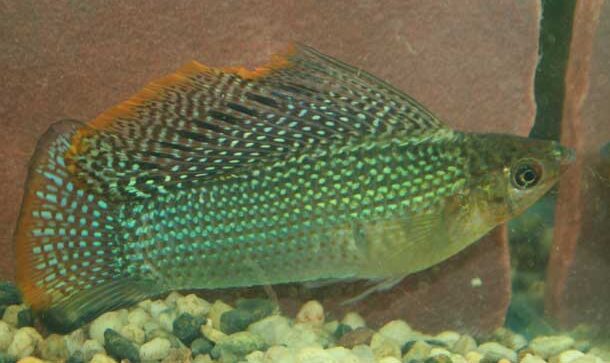The photo is of a mature male Green Sailfin Molly.
This is an aquarium strain fish we’ve been working on for quite some time. To develop this strain, we have crossed three wild sailfin mollies, Poecilia latipinna, P. petenensis, and P. velifera and have selected for large, colorful males.
We raise all three of the wild sailfins. Presently, we have three populations of P. latipinna, Coleto Creek (my favorite), San Antonio River, and Biscayne Bay. I plan to add the Guadalupe River population soon, since they are large robust fish that, unlike other mollies, live in swift water flowing over gravel bars. We now have two populations of P. petenensis, Campeche (via Clemson University) and a population we got from Bobby Ellermann. We have three populations of P. velifera, Campeche (from Clemson University), Isla Mujeres (from Armando Pou), and one from Bobby Ellermann.
The pictured male has lots of genes from Ellermann’s fish. Note the blue in the body. We are working with this fish to produce a blue molly. Also, note the orange stripe on the distal edge of the dorsal. We have crossed fish like him into our Black Sailfin line to improve their orange stripe.
While we maintain pure populations of species such as the three wild sailfins, we don’t hesitate to hybridize to develop attractive aquarium strains. There is room in the hobby for wild type fish kept pure and hybrids. All of our commercial (also called domestic) strains of mollies have been outcrossed to the three wild sailfin species to improve their dorsals, color, size, and vigor. We have used P. latipinna, Coleto Creek extensively since its males hold their dorsals erect all of the time. Its hybrids have won many awards due to this characteristic.


Sue MacMillan says
Interesting page, Charles. Hope to see more of these. I really enjoy your column in TFH too.
charles says
Sue, Thanks. I’m trying to get better about posting more about what we are doing in the hatchery. Sometimes there aren’t enough hours in the day.
We are working on some interesting new commercial mollies and I’m acquiring every wild molly species I can get.
I’ll be speaking the American Livebearer Association convention in St. Louis May 15-18 (http://www.livebearers.org/modules/content/index.php?id=51) on our Hatchery Operations and Breeding Techniques. I hope to pick up more wild species at the auction.
rjwagne2@fuse.net says
I love you exquisite green sailfin Mollies. For your wild strains what are the ideal water parameters (temperature, ph, hardness, salinity)? Do they vary greatly between the different populations? I’ve ordered some velifera and latipinna from you and want to ensure that I provide an optimal environment upon their arrival. The tanks are heavily planted to minimize nitrates. Any other suggestions? Thanks so much.
– Ron Wagner
charles says
Ron,
All the wild sailfins, Poecilia latipinna, P. petenensis, and P. velifera, like hard alkaline water and will tolerate marine conditions. At our hatchery the water is hard (285 ppm Calcium Carbonate) and alkaline (pH 8.0-8.5). P. latipinna can take temperate water conditions and survive freezing temperatures as long as it’s not cold for too long. The other two species will die at water temperatures below 50F. Our commercial Green Sailfins are hybrids of the three wild species.
We keep our mollies between 70-85F. They prefer the higher temperatures.
We don’t add salt, but if you want to use it, about 1/6 marine (6ppt) is good.
The most important thing to remember is that mollies cannot tolerate ammonia. Make sure you have a well-cycled tank with adequate nitrifying bacteria. I suggest two filters, each rated to handle the entire tank. The filters shouldn’t be cleaned at the same time. Alternate cleanings to insure adequate colonies of bacteria. Plant as hornwort are desirable since they will use ammonia.
I hope this helped,
Charles
john mclaren says
Hi, loved your work with sailfins. I just returned from mexico Feb.10 2015 and was fortunate enough to have a great snorkelling river right at the edge of our resort that was full of wild green sailfins. these were beautiful fish in bunches of 60 – 80 fish and I’m sure some were 6 ins. long and nice robust bodied fish. Was the highlight of my vacation as I have had these aquarium mollies and it is really nice to see what they can really look like in their natural habitat. Thank you for your work with mollies.
Friends of fish john McLaren
charles says
John,
Wild mollies, especially the three sailfin species, are wonderful fish. I never tire of seeing them in the wild. When my wife and I honeymooned in Isla Mujeres, Yucatan, Mexico, it was difficult for her to pull me away from the beautiful sailfins in island’s lagoon.
Charles
Brody says
They aren’t on the website but I was wondering if I can buy some of them
Charles Clapsaddle says
Brody, First, sorry for the tardy reply. Your message just appeared. We are rebuilding our livebearer breeding colonies after massive losses from the Texas Winter Storm and its aftermath. We should be offered Green Sailfins later this summer.
Charles
Gus Cannon says
Interested in purchasing green fin mollies to EST aphids on my water pillows on my 700 gallon outdoor pond
Charles Clapsaddle says
Gus, I’ll be collecting some Coleto Creek Poecilia latipinna this summer. They are the cold hardiest of the mollies.
Charles
TONY J FINAZZO says
I am interested in buying some green Salefin Mollies
Charles Clapsaddle says
Tony, Email me at charles@goliadfarms.com, and I’ll add you to our new tickler file so I know to contact you when they are available.
Charles
S.madhavan says
Do you ship them to India
Susie Clapsaddle says
Unfortunately, we do not ship internationally. We could work with a transhipper of your choice.
Charles